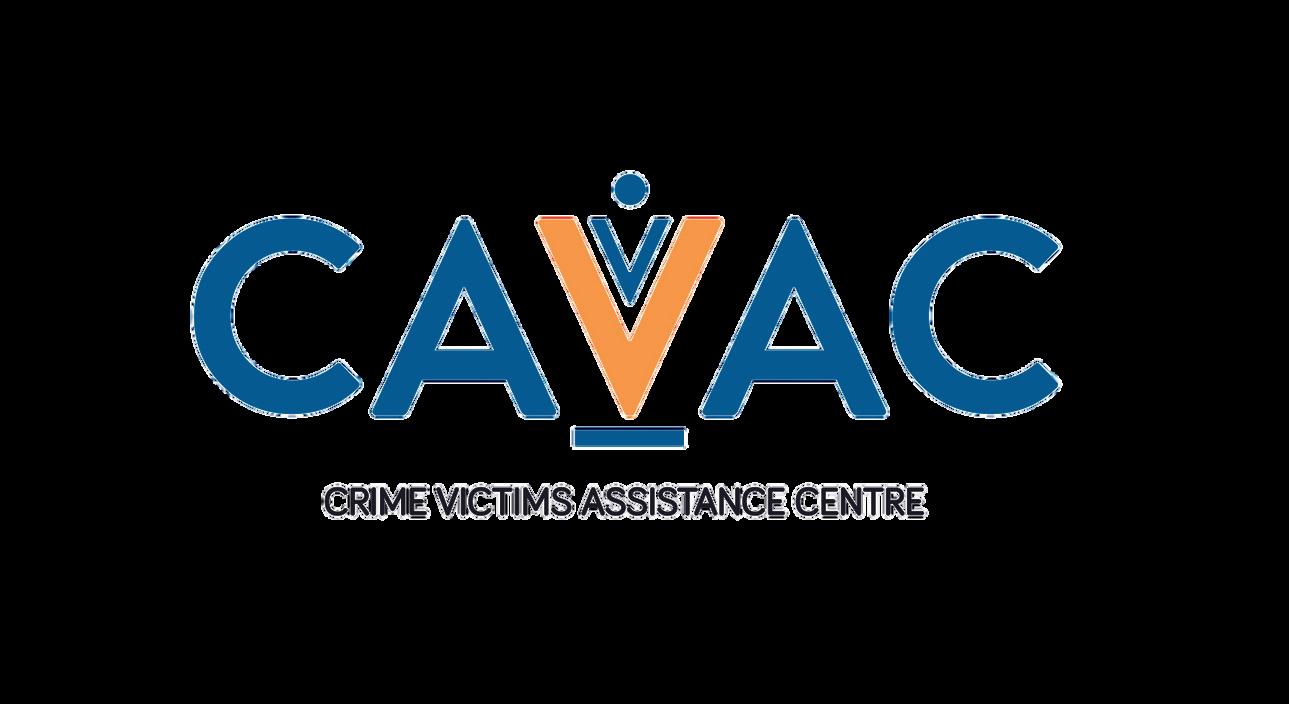
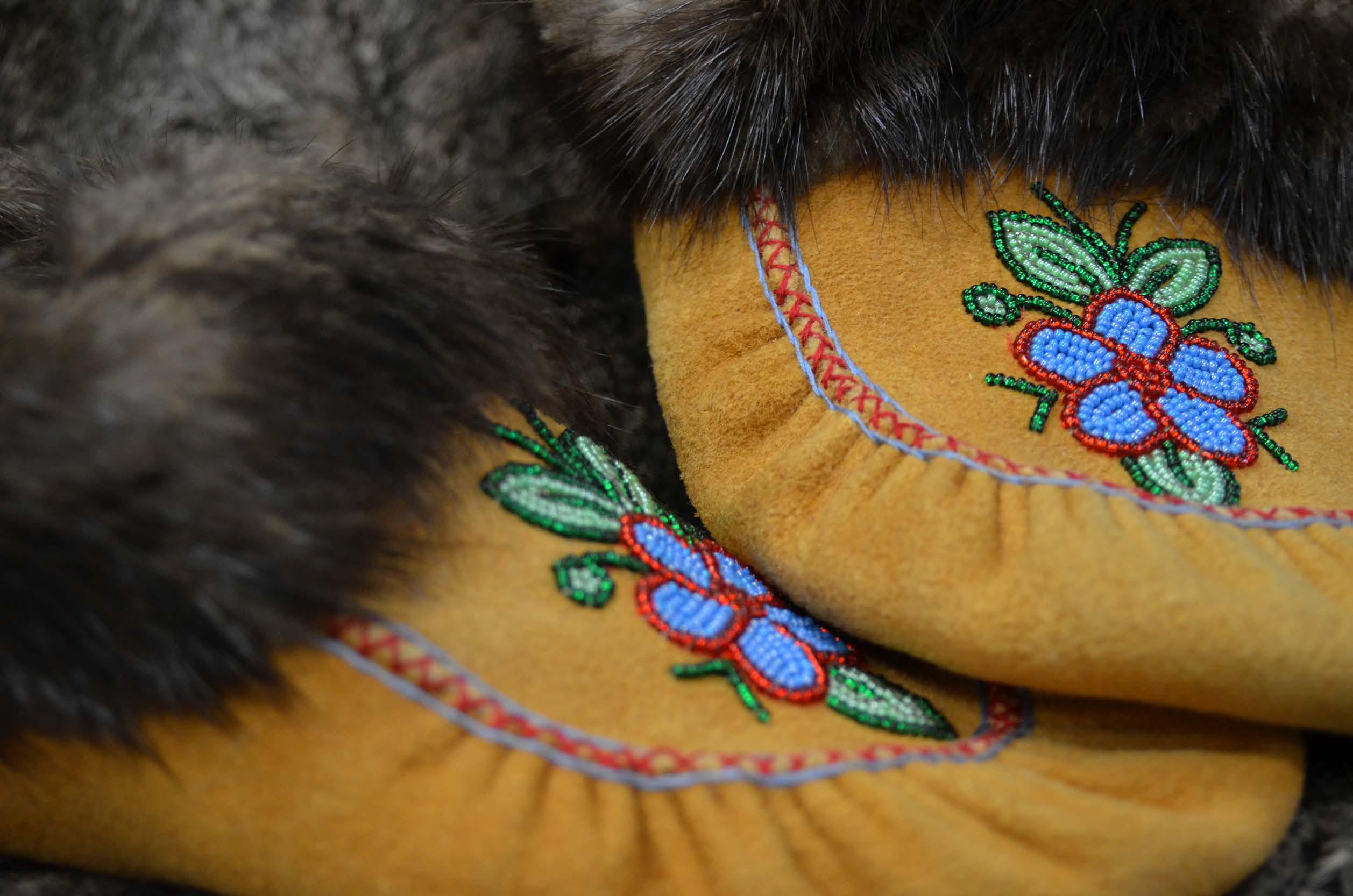



Join us for the soft opening on July 30, 2024 from 3-7 PM
79 Rue Saint-Paul E, Montreal, QC










by Will Nicholls
According to the famous quote from philosopher George Santayana, “Those who cannot remember the past are condemned to repeat it.” It appears that Quebec Premier François Legault is not familiar with it.
Legault doesn’t understand that history doesn’t belong to just one people, society or culture. This is evident from the statement he made last April about the planned creation of a Museum of Quebec History. Legault said then that Quebec’s history “began with the explorers, Cartier, then after that Champlain, who is the founder of our nation.”
Even on its merits, Legault is shockingly uninformed. Champlain, for instance, never considered the lands along the Saint Lawrence River as anything but a part of France. But on a deeper level, to say that Quebec history began with these two men is simply ignorant, if not worse.
The Assembly of First Nations QuebecLabrador attempted to “remind the Quebec Government that Quebec’s history began long before the arrival of Europeans on the territory.” Calling the statement part of the “systematic erasure of our common past,” AFNQL Chief Ghislain Picard emphasized that Champlain’s arrival did not define Quebec. Historians, both Indigenous and non-Native, agreed.
The government backstepped when Indigenous relations minister Ian Lafrenière acknowledged that Indigenous Peoples were here long before the French explorers and that they had contributed to Quebec’s existence and history. He felt this should be part of the proposed museum.
Of course, the words of Legault are nothing new to First Peoples in Quebec. After all, he refuses to recognize there
is systematic racism in this province. His words about Cartier and Champlain only confirm that this is the case.
Earlier this year the AFNQL gave the CAQ government a report card on their relations with First Nations. First, the sortof-good news.
Youth Protection got a C- along with early childhood. Economic development and housing for First Nations people in urban areas got Cs. Both were found to have problems, though. Economic measures were found be useful but sadly insufficient to bridge the economic gaps between First Nations and the rest of Quebec society. Housing challenges were many, including scarcity, affordability, prejudice, mistrust, language, culture, food and more. First Nations are over-represented in the homeless in many urban communities and cities.
The bad news starts with a D on cultural safety. A law enacted in 2023 deals only with awareness and doesn’t contain any real consultation with First Nations.
Quebec received an E for its caribou protection strategy. The province has postponed efforts to address saving the herds and only recently announced

pilot projects that the AFNQL say “are far from satisfactory.” Energy development and on-reserve housing are yet another sore point.
Some of the biggest problems are with the adoption of the United Nation Declaration on the Rights of Indigenous Peoples. In 2019, Legault’s party, the Coalition avenir du Québec, recognized UNDRIP. But the Legault government refuses to follow his own party’s policy.
As premier, Legault has also challenged the rights of First Nations to manage their own child welfare systems, which was recognized by the federal government’s Bill C-92. Quebec has lost several court challenges to this law, but still thinks that Indigenous children should be wards of the state.
It’s two years before the next Quebec election so there is plenty of time to prepare for it. Despite Legault, there are CAQ party members who are open to Indigenous ideas. In the meantime, we should approach them and see how we can change the historical nature of our relationship – before mistakes of the past are repeated.
Legault doesn’t
understand
that history doesn’t belong to just one people, society or culture
The Nation is published every two weeks by Beesum Communications EDITORIAL BOARD L. Stewart, W. Nicholls, M. Siberok, Mr. N. Diamond, E. Webb EDITOR IN CHIEF Will Nicholls DIRECTOR OF FINANCES Linda Ludwick EDITORS Lyle Stewart, Martin Siberok MANAGING EDITOR Randy Mayer STORY COORDINATOR Patrick Quinn
CONTRIBUTING WRITERS X. Kataquapit, S. Orr, P. Quinn, J. Janke, H. Nicholls DESIGN Matthew Dessner SALES AND ADVERTISING Danielle Valade, Donna Malthouse THANKS TO: Air Creebec
CONTACT US: The Nation News, 918-4200 St. Laurent, Montreal, QC., H2W 2R2 EDITORIAL & ADS: Tel.: 514-272-3077, Fax: 514-278-9914 HEAD OFFICE: P.O. Box 151, Chisasibi, QC. J0M 1E0 www.nationnews.ca EDITORIAL: will@nationnews.ca news@nationnews.ca ADS: Danielle Valade: ads@nationnews.ca; Donna Malthouse: donna@beesum.com
SUBSCRIPTIONS: $60 plus taxes, US: $90, Abroad: $110, Payable to beesum communications, all rights reserved, publication mail #40015005, issn #1206-2642 The Nation is a member of: The James Bay Cree Communications Society, Circle Of Aboriginal Controlled Publishers, Magazines Canada Quebec Community Newspaper Assn. Canadian Newspapers Assn. Les Hebdos Sélect Du Québec. Funded [in part] by the Government of Canada. | www.nationnews.ca | facebook.com/NATIONnewsmagazine | Twitter: @creenation_news




Mistissini hosted a Youth Empowerment Conference July 9-11, showcasing a mix of inspiring speakers, workshops and activities. Reflecting on this year’s theme of self-excellence, presenters shared how they overcame obstacles to achieve their goals.
“It’s pushing youth to reach their potential, to break out of their shells and inspire them to look at new opportunities for themselves,” explained Mistissini Youth Chief Justice Debassige. “We try to invite as many people of different backgrounds as possible to share their stories. No matter what you do, there’s always room for improving yourself.”
While the event featured entrepreneurs, artists and other motivational speakers, there was a stacked lineup of elite hockey players – including NHL prospect Israel Mianscum, former Panthers and Canucks defenceman Brady Keeper from Cross Lake First Nation, and Brigette Lacquette, who played on the Canadian women’s Olympic hockey team and is now a scout for the Chicago Blackhawks.
As Mianscum was training in Montreal after recently signing with the Canadiens, he delivered his presentation online. “He insisted on being part of the conference,” said Debassige. “He appreciates the support and wanted to give back to the community in some way.”
On the first day, Jade Mukash shared her journey since becoming Miss Whapmagoostui and being selected from over 700 applicants to be one of 26 contestants in the upcoming Miss Indigenous Canada pageant.
“It has to come from within to push yourself to take your title to the next level,” said Mukash. “It definitely opened more doors, made me recognize my gifts and how I want to give back to my nation and community. By sharing my story of everything I did independently, I hope to see more of that from local princesses in the future.”
by Patrick Quinn, Local Journalism Initiative Reporter
Mukash overcame self-doubt to engage in meaningful work. For her, that means supporting charity organizations and connecting with other First Nations. She is excited to return to the community to paint a mural for the Eeyou Istchee Summer Games.
“Going into pageants was a dream come true for me,” Mukash told the Nation. “I shared different ways to be involved and what it means to be a princess. It’s not all about beauty or the dresses I wear. It’s more about being an ambassador and an advocate.”
Award-winning Blackfoot filmmaker Cowboy Smithx delivered the event’s final speech. While Smithx is active in the Calgary arts scene, contributes to various festivals, film projects and theatre productions, he says his message applies equally to engineers, doctors and environmental scientists.
“I encourage everyone to explore their curiosities and know that things are always in flux,” said Smithx. “You may feel you want to be a lawyer today but 10 years from now you may want to be a culinary master. Keep an open mind and be present with the moment itself to renew that relationship with your body and mind over time.”
Smithx shared his methodology called “Avatriix” (ah-vay-tree), a word he coined that means “harmony across multiple dimensions, informed by the natural cycles we see in nature.” This philosophy guides his highly acclaimed REDx Talks, which have emerged as an influential space for shared experiences, wisdom and reconciliation.
“To reconnect frequencies of the land we’ve lost to colonization is a key component to navigating the entanglements of modern life,” Smithx asserted. “I talk about my process of creating something from scratch, leaning into thousands of years of connection to our ancestral plain as a foundation to build new ideas and tackle emerging problems.”
Suggesting young people should “embrace the authenticity of their lived experience,” Smithx said he felt right at home in Mistissini. He hoped to return to lead a more hands-on effort to encourage creative projects.
In addition to business workshops led by Gilles Matoush and Lacey Biedermann, Eeyou Istchee Lifestyle founder Raymond Jolly discussed launching his apparel brand that celebrates Indigenous pride. Stacy Anderson hosted a wellness workshop to help youth recognize signals that someone may require support.
“Mental wellness is something you can’t see like physical health,” said Anderson, a mental-wellness professional with regional public health. “When your friend is injured, you don’t poke at their injury. I don’t want youth to feel alone, and I want their peers to have the tools to support their friends.”
She focussed on signs that friends may be distancing themselves, suggesting they may just need a listening ear. With antisocial behaviour rising since the Covid pandemic, the community has established peer support groups and other services.
A mobile youth clinic to make CMC health services more accessible and less intimidating was launched at the event. Healthcare professionals will be available at the youth centre weekly with addictions specialists leading workshops and directing youth to appropriate resources.
As a youth development coordinator five years ago, Anderson worked with former youth chief Samantha Awashish to introduce the first youth empowerment conference. Debassige said they plan to return bigger and better in two years.
“The youth department did an amazing job in providing tools youth can use in their everyday lives,” said Anderson. “The vibe is very uplifting with everything going on. It’s so nice to see how much it’s grown from where we started.”
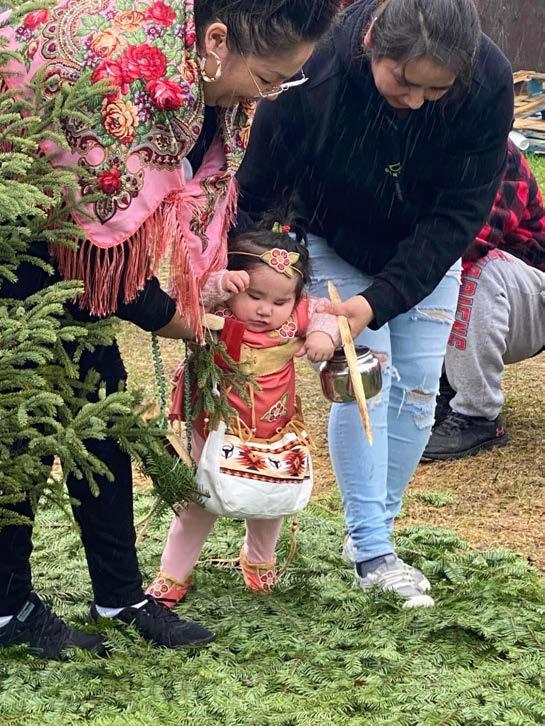

FOR NOT-FOR-PROFIT BUSINESSES WITH A SOCIAL OR CULTURE COMPONENT
75% of project cost, up to $25,000
Training and coaching
Pre-start up and start-up fees
Equipment or supplies purchases
Feasibility and marketing expenses FOR MORE INFO Social Economy Advisor EXAMPLES OF SOCIAL ECONOMY PROJECTS:

Meals on Wheels
Greenhouses
Local transportation
418-923-2901 ext. 3409
peggy.petawabano@cngov.ca
www.cngov.ca
Department of Commerce and Industry



by Patrick Quinn, Local Journalism Initiative Reporter
WIhile Quebec has largely been spared the disastrous forest fires that plagued the north last summer, blazes that erupted near Nemaska in early July showed how quickly the situation could change. The Route du Nord was closed preventatively July 8 following the detection of fires and hot spots on the western side between km 306 and 320, and on the southern part between km 150 and 180.
Closure points were set up at km 4, near Chibougamau, at km 407, and the junction with Billy Diamond Highway at km 274. Another closure point was established at km 394 of the Billy Diamond Highway, where the Muskeg access road begins.
“We did have the three fires near the road near Nemaska and I believe they had another seven fires on the Route du Nord towards Chibougamau,” said Nemaska fire chief Kurtis Black. “Since that’s in an intensive zone, there were water bombers in Chibougamau initiated towards those fires.”
With many people attending the annual gathering in Old Nemaska, the community dispatched first responders and firefighting equipment to the area as a preventive measure. About 40 SOPFEU personnel were also present. Fires had reached as close as a half kilometre from Old Nemaska road and about 5 km from the Nemaska turnoff junction before being extinguished by rain.
Another fire, number 256, had gotten to about 10 km from the community on the other side of the lake but swiftly diminished when it hit an island with muskeg. Most concerning at press time was a quickly growing fire about 30 km northwest of Nemaska, which Black said SOPFEU would attack if it came any closer to Hydro-Québec infrastructure.
Due to increasing fire risk, on July 11 SOPFEU banned open fires in the vicinity of forests and the cancellation of industrial burning permits, which includes burns to destroy material felled during deforestation. With $29 million in new funding, the provincial forest fire prevention agency aims
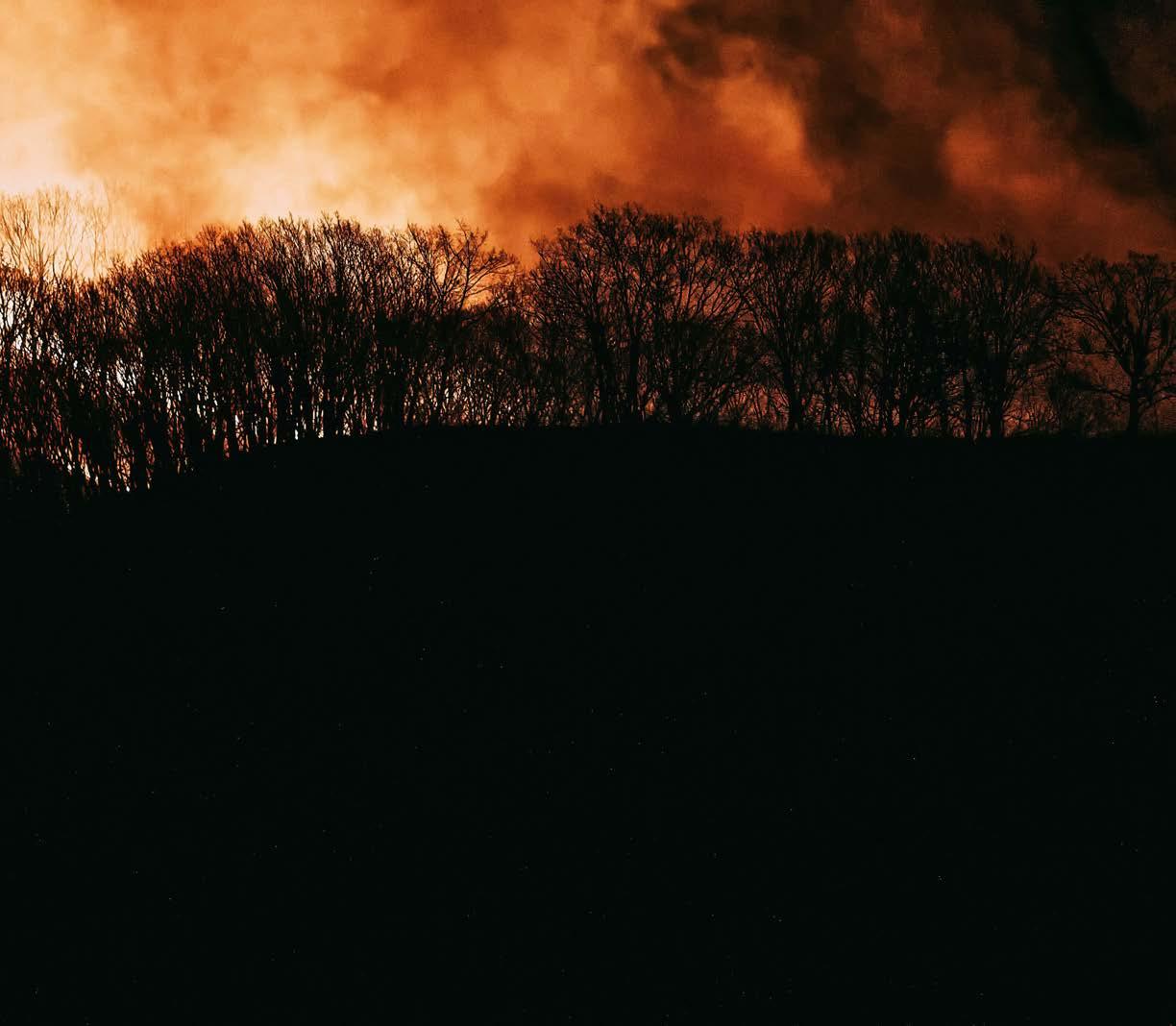
to hire 80 new firefighters in the next two years, increasing staff by 32%.
With fires near Quebec’s northeast border forcing thousands to evacuate from Labrador City, the town of Fermont recently planted a shield of deciduous trees along its perimeter, in association with Arbre-Évolution. The town had previously reduced density of conifer trees near residential buildings, which the organization said are full of organic oil “like a forest of matches.”
Following last summer’s record-shattering wildfire season, governments are increasingly leveraging both new technologies and ancient wisdom. In BC’s Okanagan Valley, the Syilx First Nation has been successfully leading traditional prescribed burning practices with the full support of BC Wildfire Service.
“They came with open hearts and minds, wanting to understand and work with Indigenous people,” said James Pepper, the sn’pink’tn community’s natural resources manager. “It’s great the province and federal government are starting to realize how important that proactive approach is.”
As the culture’s burning practices had long been outlawed, some techniques had to be modernized to account for decades of accumulated tree debris and other surface fuels. Technologies like environmental monitoring and mechanical tree removal are seated within the Indigenous paradigm.
With lower intensity burns to maintain plant roots and fungi, Syilx firekeep-
ers would traditionally work when the snow recedes in early spring, focusing on patches dried by the sun with the remaining snow acting as a natural fire break. As more snow melts, the previous burns would serve as fire breaks for further work.
Traditional firekeepers work in two-person crews with vast knowledge of soil moisture levels, the land’s slope and other aspects. Before the prescribed burning process begins, a land “treatment” may consist of a fuel cleanup, stem pruning and some pile burning.
“One Syilx methodology is to carefully prepare the land before the burn, for example, by strategically placing debris,” Pepper told the Nation. “It’s very relevant what the conditions are after the treatment’s been done. These days it’s a hybridized approach that’s Syilx-led with very strong collaborative work that makes the whole process much stronger.”
The project has become recognized as a best practice in the field, with treatment areas effectively working as a break against three intense fires in the past two years. The community’s youth have enthusiastically absorbed traditional practices and joined the team, with two former employees starting their own companies focused on prescribed burning.
While many First Nations are reviving this millennia-old tradition to reduce risks, rejuvenate lands and return natural habitats, numerous communities are also integrating emerging technologies to battle blazes. Cree fire chiefs have been
increasingly looking to satellite imagery and drones to stay ahead of wildfire risk.
“We have one active fire right now, and there’s no way of getting to it except by helicopter,” said Kurtis Black. “We go observe them and send the drones in to get a better perspective and transfer all that information to CNG and SOPFEU. Drones make a big difference. We started with them about two or three years ago –we’re trying to get training from Transport Canada.”
While drones can currently be used for “hot spotting” fires invisible to the naked eye with thermal scanners, last summer Transport Canada authorized the operation of drone swarms for fighting wildfires. US agencies use drones that drop “dragon eggs” that detonate with extinguishing chemicals. University of Calgary researchers are testing military predator drones that could travel farther to release water, even scooping up water from lakes inaccessible to piloted planes.
Hoping for a storm with plentiful rain, Black continuously monitors weather data from various apps. He was only half joking when he said, “You need an IT guy at all times.”
“We’ve got to check the weather channel every day,” said Black. “When I went to bed last night, it said five days of rain. When I checked this morning, two days. You try to depend on Mother Nature to put them out, but sometimes it doesn’t work that way.”
Do you know that the Nation is also available in e-Edition?

As readers continue to shift to digital reading, newspapers are evolving to engage with readers in new ways.
The Nation can be read cover to cover, on Issuu, straight from the Nation website.
It's exactly like the print magazine. Past issues, as far back as 2018 can also be read on the Nation website. All issues are available for download.
You are travelling, even to Timbuktu, and cannot pick up a Nation copy? Maybe you prefer to read on your device?
The Nation has you digitally covered. Check us out!
The Assembly of First Nations (AFN) welcomed delegates from hundreds of First Nations for its 45th annual general assembly July 9-11 on Kanien’kehá:ka (Mohawk) territory in Montreal. Under the theme “Strengthening our Relations,” delegates looked to turn the page on the controversial era of RoseAnne Archibald, who was removed as national chief last year.
On the first day, a resolution agreed that the forensic audit of the organization called for by Archibald was not warranted and shouldn’t be undertaken. Other resolutions addressed financial security for regional offices, clarifying voting rules, supporting their 2SLGBTQ council, and establishing an accessibility and disability advisory council.
With longstanding calls for Indigenous policing programs to be recognized as an essential service, National Chief Cindy Woodhouse Nepinak invited Public Safety Minister Dominic LeBlanc to discuss the issue. Attendees were disappointed by his remarks suggesting rights-based discussions are a “more complicated conversation.”
While several federal politicians made speeches, a group protested Conservative leader Pierre Poilievre by turning their backs when he spoke from the podium. Yukon delegate Duane Gastant’ Aucoin, co-chair of the AFN’s two-spirit council, said he couldn’t sit there in good conscience without doing something.
“Him and his party are very vocal on attacking two-spir-
it rights across the country,” said Aucoin. “They took off pretty fast after they received an earful from all the chiefs there.”
On the final day, Woodhouse Nepinak confirmed AFN had secured a federal commitment for $47.8 billion in funding over 10 years for long-term reform of First Nations child and family services. She said they want to reform the “broken system... moving towards prevention rather than apprehension.”
The proposed settlement worth more than double what was originally promised in 2021 includes funding for housing and adjusted funding for remote First Nations. In the coming months, the AFN will meet with First Nations leaders at regional sessions to discuss its details before voting on its ratification at a special assembly in September.
As a youth, Chef Zach Keeshig noticed that the fragrance of sweetgrass reminded him of vanilla. Now the Indigenous chef is teaming up with frozen treats company Chapman’s to create a limited-edition ice cream flavour.
Called Wiingashk (Ojibwe for sweetgrass), Keeshig said the green result with hints of maple syrup tastes like a floral version of vanilla. Ice cream has always been part of the nine-course tasting menu at his restaurant Naagan in Owen Sound, Ontario.
“As we started doing these tasting menus, we wanted to get rid of using vanilla because it didn’t come from Canada,” recalled Keeshig. “When I was younger, my dad would have sweetgrass hanging in his truck. And I remember when my dad lit it and doing smudging with him when I was younger, smelling faintly like vanilla.”
Not wanting to use the dried sweetgrass used to cleanse the body in smudging ceremonies, Keeshig began foraging and growing his own local plants, which soon expanded to sourcing other local ingredients for his restaurant.
A mutual friend connected Keeshig with Ashley Chapman in 2020 when the company was looking for an Indigenous chef to cater an upcoming event and create a new ice cream flavour that was totally Indigenous.
“He’s got such an interesting mind as far as being a French-trained chef and incorporating all of these things from Indigenous culture,” said Chapman. “What he is doing is truly pioneering.”
The sweetgrass ice cream will be served exclusively at an upcoming Indigenous fashion show, hosted by Seeing Red Media in Toronto. But if it is well received, it may be considered for a small production run at the Markdale factory.
EEPF makes drug busts
On July 4, Mistissini officers of the Eeyou Eenou Police Force in collaboration with the Sûreté du Québec’s Chibougamau detachment found a car loaded with eight cases of alcohol, 11 ounces of a substance suspected to be cocaine and illegal pistol ammunition with a combined street value of $40,920.
A search of the subject’s residence found additional white substances that were seized. A 33-year-old male and 30-year-old female were arrested and are awaiting their phone appearance before a judge in Chibougamau.
In Waswanipi, over half an ounce of cocaine was seized during a house search with a male and female arrested. Both suspects were released with a promise to appear in court.




Iby Will Nicholls

t wasn’t a dark and stormy night but rather a hot and muggy Friday morning when I picked up my sons Hunter and Declan to attend Montreal Comiccon 2024.
Comics have been a large part of my life that eventually led to reading novels without giving up the comics. One of my first girlfriends as a preteen was Sandra Nash, who will never be forgotten. That’s because, when she moved away, she gave me her comic-book collection. It was one I pored over again and again, reading, rereading and talking about them. Perhaps that’s why I remember Sandra so well as she encouraged and shared my love of reading.
Starting off with comic books is great as the pictures resonate with the words and helps you to remember them, especially when you reread them as much as kids do. It is a love that I still have to this
day and was glad to have my two boys so excited to attend Comiccon.
This Comiccon was billed as something special. It was the 40th anniversary of A Nightmare on Elm Street. Robert Englund, the original Freddy Krueger, would be there as well as five other cast members. They would be signing autographs and having photos taken with them. But there’s a price for fans to pay. Some stars charge $20 for an autograph. A great deal if you have an original movie poster, comic book or other memorabilia.
Apparently, Lou Diamond Phillips was around, but we heard he was charging $200 for a special photo with him. Unfortunately, we didn’t find out where and when these photos were taking place. Just walking around, I swear we saw Keanu Reeves, but it could have been a stunt double or just someone who looked like him. We were unsure as
Reeves supposedly likes to mingle with the rest of humanity as an average person.
For those into anime, there were hordes of fans dressed up as characters from the show One Piece. Monkey D. Luffy, leader of the Straw Hat Pirates, was a favourite among both adults and kids. Buggy the Clown, a favourite bad guy from the show, was represented by actor Jeff Ward, who plays him in the series.
Personally, I prefer the live-action show to the anime series, but the Netflix show just started last year whereas One Piece began in the late 1980s in manga books. It is the best-selling Manga series and the best-selling series in comic series in printed books.
These are Japanese illustrated books that go beyond the comic books we grew up with. In the 1990s, anime jumped in, and things went crazy. To date, there are over 1,100 TV and internet anime episodes with legions of fans. On August 31, 2023, One Piece was launched as a live-action
series. By September 15, two weeks later, it had been renewed for a second season, which fans are eagerly awaiting.
One Piece wasn’t the only anime series to attract fans, costumed or not, as Sailer Moon and others joined the party. There were almost as many people in costumes as not. Missing a photo-op was the parade of Star Wars Dark Forces with an Evil Emperor, Sith, Darth Vader, his son, and Storm Troopers.
Canadian content was present as we learned that sort-of-hero Wolverine turned 50 this year. A call to have the most fans dress up as Wolverine to set a record wasn’t seen on the floor during the two days we attended.
One of the interesting guests was Jim Shooter. This Elder is a true role model for youth. You see, he started his comic-book career at the age of 13 with DC Comics. Back then comics sold for 12 cents, and he created a Legion of SuperHeros story (Adventure Comics #346). DC
said his age was no problem with what he could produce. Besides the Legion stories, he branched out into Superboy and Superman.
In 1978, Shooter became the editor-inchief of Marvel Comics, who had headhunted him after seeing his talents. As editor-in-chief, he introduced royalties, rights and other benefits for comic-book creators. He also was instrumental in having Mattel create toys promoting Marvel heroes.
You think this would be enough for one guy, but Shooter went on to found Valiant Comics in 1989, Defiant Comics in 1993 and Broadway Comics in 1995. Despite his greying hair, Shooter hasn’t stopped working and is a consulting editor and freelance writer for Illustrated Media.
Shooter’s impressive career goes to show that whether you’re young or old, there is no age limit to being a part of the comic-book world.


by Hunter Nicholls
Comiccon is one of Montreal’s most exciting experiences and has evolved into something everyone can enjoy.
Comiccon 2024 had many enjoyable things to see from merchandise to testing games, making my visit a very eventful two days. It was a large and open space with different shops and displays with merchandise from numerous loveable franchises, so it was a little overwhelming at first. There were tons of great displays such as a Ghostbusters exhibit and a Star Wars exhibit. The spaces with shops

sold many different things ranging from Funko Pops to real katanas. It was great to see what people were selling and if the items would be worth buying.
I enjoyed the diverse number of franchises; they had many different fans of different things. They had merchandise and fans of video games such as Undertale, Elden Ring and Halo. They had many amines such as Dragon Ball Z, One Piece, Naruto, Demon Slayer and Bleach. Plus, there were TV shows and movies like Marvel and DC.
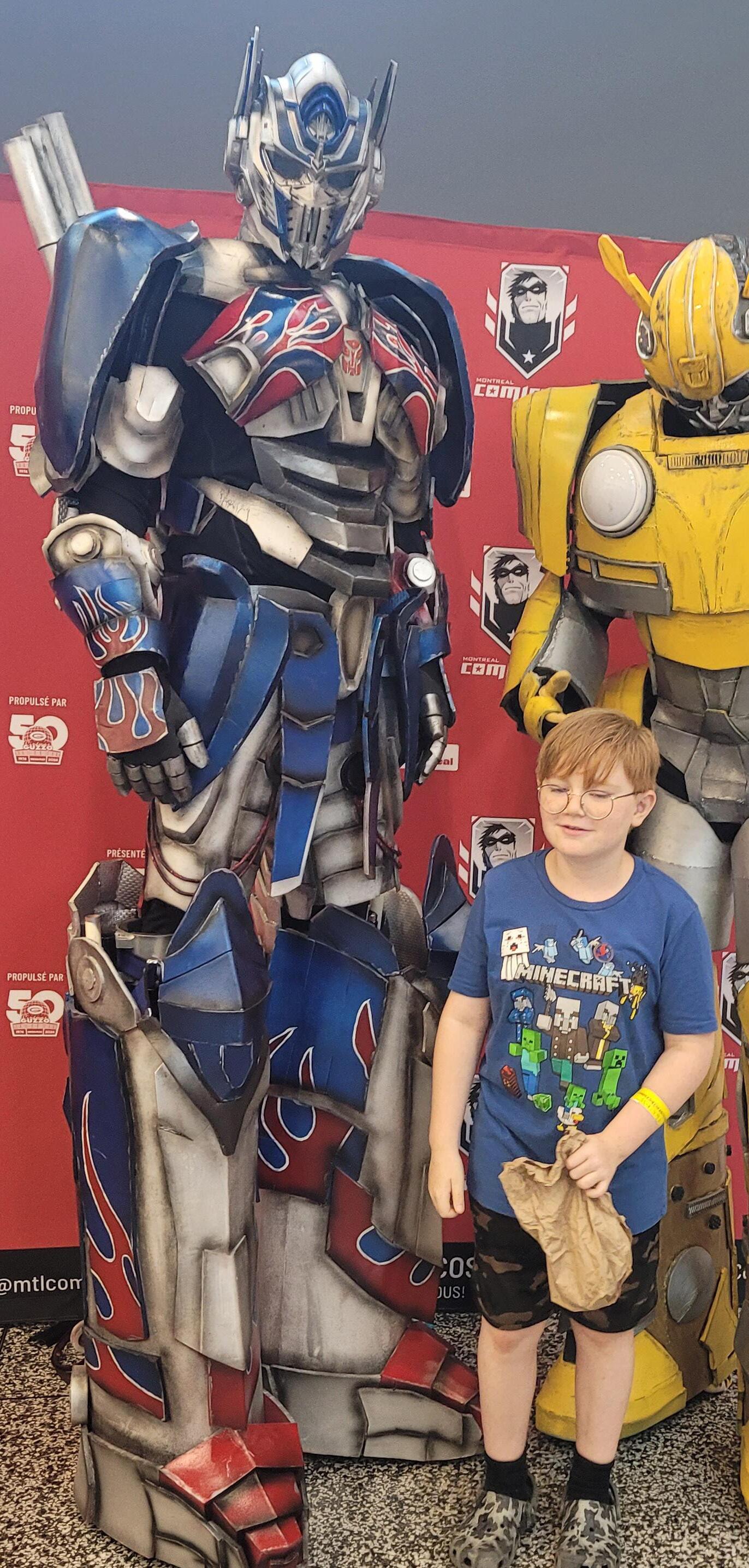
On top of that, many celebrities were there. I decided to meet two of them –Giancarlo Esposito, aka Gustavo Fring in Breaking Bad and Moff Gideon in The Mandalorian as well as voice actor Eric Vale, aka Trunks and Future Trunks in Dragon Ball Z and Dragon Ball Super, and Sanji in One Piece.
I find an important part of Comiccon are the fans’ costumes and cosplays. If you visit Comiccon, many people are wearing costumes of their favourite characters. It’s amazing to how much dedication and effort people put into their costumes.

They were also live streaming on Twitch from the video game area. It was three people just talking and playing a video game similar to a podcast. The game area consisted of eight stands with different games and in the middle, there was a place with a big screen and bean bags for a different game, at the bottom there were a bunch of tables. At the tables there were the same card game put all over them for people to try. In the main game area, you could test different indie games such as Aloft which I thought was pretty cool.
Next to the gaming area there was a small area with places you could take


photos with, such as a chair you could sit in, Teenage Mutant Ninja Turtles you could take photos with and another Star Wars thing to take photos with as well.
I’d heavily recommend going to Comiccon next time it’s in Montreal or in a town near you. Comiccon is a great convention, and you will enjoy it very much. Overall, it was a great event and I look forward to attending it next year
The spaces with shops sold many different things ranging from Funko Pops to real katanas




















by Joshua Janke
Photos by Lori Calman
Kahnawake was the place to be July 13-14, as the 32nd Echoes of a Proud Nation Pow-Wow danced and drummed its way into the record books with over 20,000 people coming together to celebrate Mohawk traditions. Blistering temperatures over 30 degrees did nothing to discourage the crowds. Iced strawberry juice was in high demand as people eagerly soaked up a spectacular 48-hour event where the sunshine and celebration seemed infinite.
Held on the second weekend of July, the event marks the anniversary of the 1990 Oka Crisis, when the Mohawks stood together to protect their territories. The powwow is a time of sharing stories and dances, of laughter and friendship. It is a
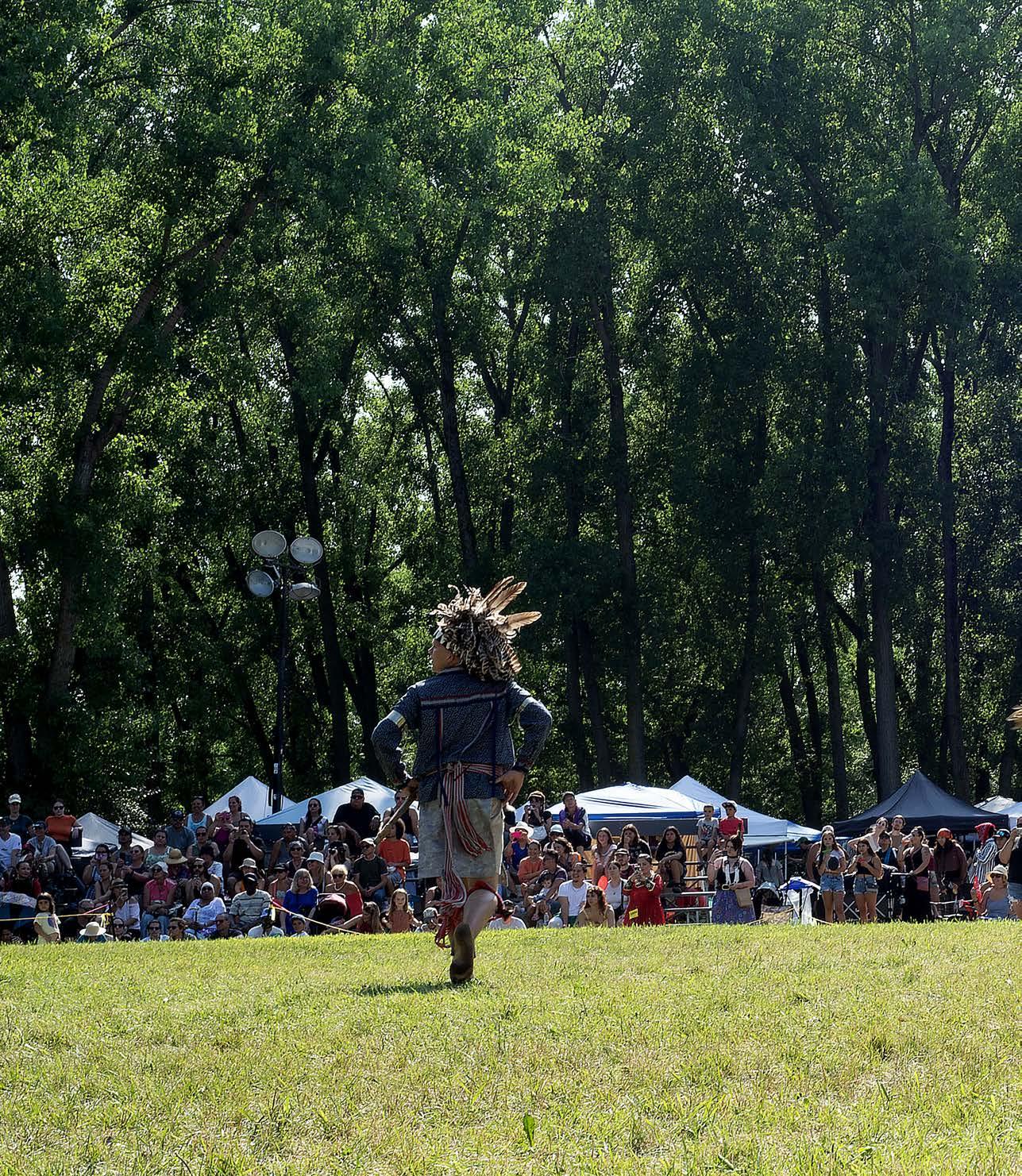
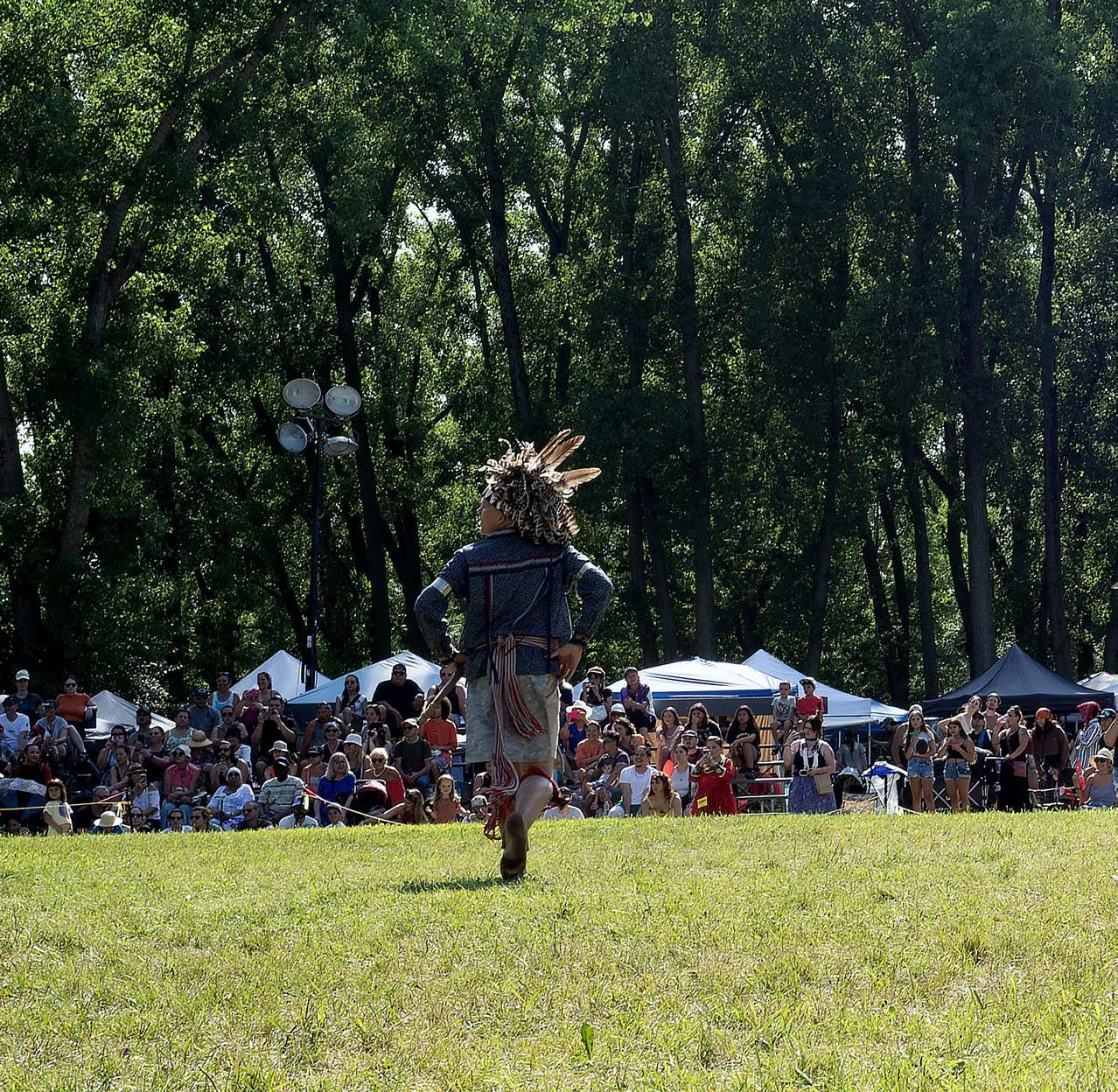

time to renew old connections and forge new ones.
Elder and veteran Ray Kaniehtakta Deer took the time to step back and appreciate what was going on.
“It’s such a big attraction. Everybody looks forward to it, in particular the dancers,” said Deer, who dances with his family. “A lot of families are very inspired by their dancers, and there’s just so much support. Most of us aren’t there for the competition; we’re there for the family and community gathering.”
This year, Deer was again honoured as the powwow’s Head Veteran. He shared how the powwow fosters strong bonds for life. “It’s at the powwow that you will see the part of the community that you haven’t seen, where you see the people
beyond the community that you’ve met maybe only once, or only at the powwow,” he said. “One day I’m at Walmart thanking my cashier, and then I see them come to our powwow, and now we have a family picture together.”
Describing it as an “extended friendship,” Deer’s definition of powwow comes from years of experience. He started powwow dancing in the late 1980s while stationed in Germany, where he met soldiers from the Sioux and Blackfoot Nations who convinced him to join an upstart powwow exchange group.
“The idea was holding mini powwows at different bases across Europe,” Deer recalled. “It was a way of sharing our different Native cultures with each other
while away from our common home of Turtle Island.”
When he returned to the US in September 1991, Deer heard news from Kahnawake – his community had just announced their own powwow. Ever since its debut in 1992, Deer and his wife Sharon have been participating in the event, raising their children and grandchildren in the powwow tradition.
“For a dancer and a veteran, there is no greater honour than being asked to be the Head Veteran or Head Dancer at any powwow,” he said. “Being asked to be the Head Veteran at your hometown powwow? That is not only an honour; it is very humbling.”
With over 90 craft and culture vendors installed in loops leading to the centre


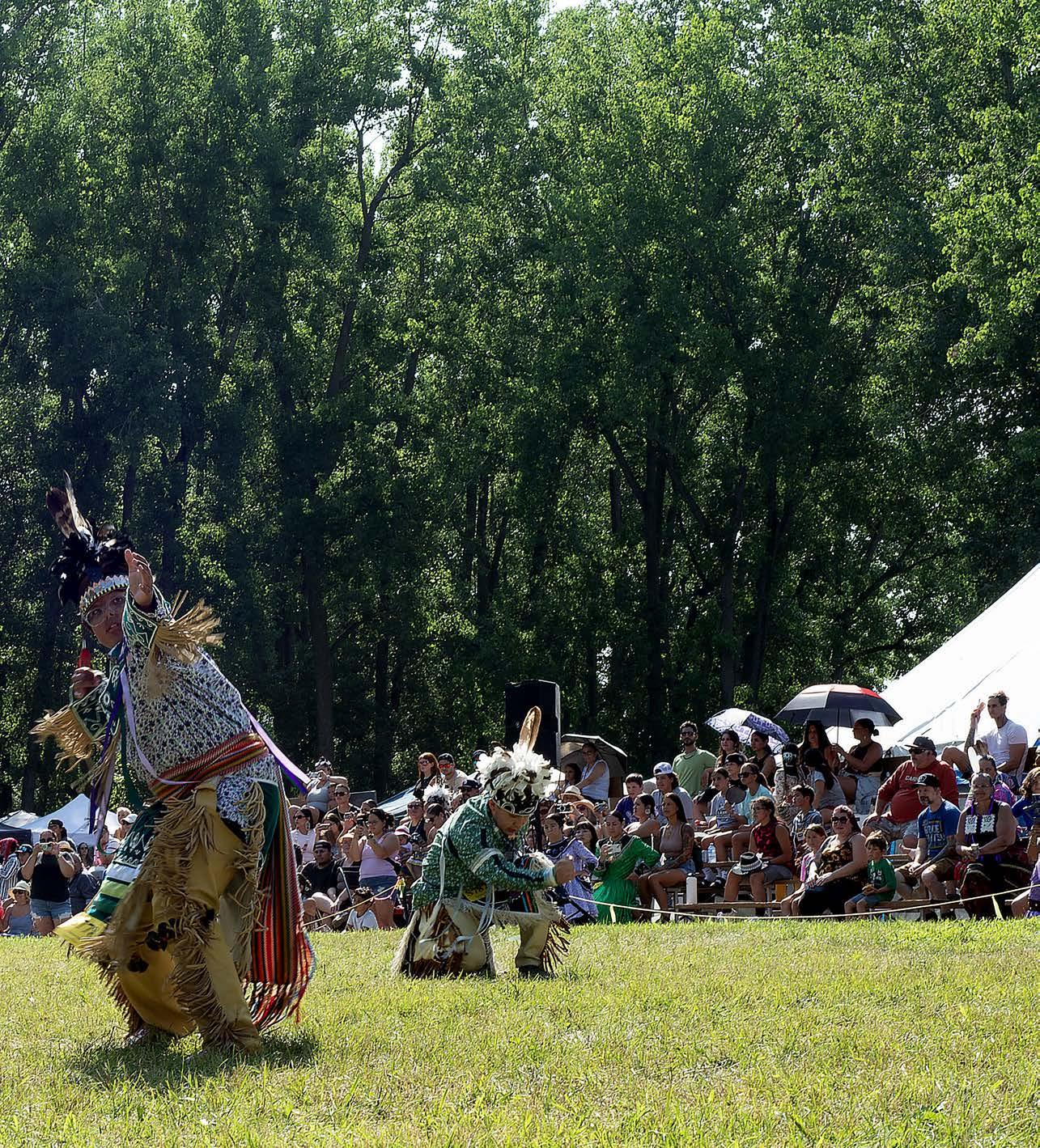
dance stage, there was something for everyone. Indian tacos and fresh walleye nuggets were among the biggest hits at the banquet of food vendors, and it seemed like the only people without iced strawberry juice in hand were those in line to get one.
“We just keep seeming to get bigger and bigger every year,” said organizer Lynne Norton. “We let everybody know about it, and now everyone wants to come.”
The excitement was contagious, said returning food vendor Caroline Griffin, cooking traditional delicacies under the name Adrianna’s Den. “We’re treated like someone has thrown down the red carpet for us,” she said as Saturday’s opening lunch rush began.
Making the trip from Ontario each July, Griffin has attended the powwow 22 times, with many happily waiting in line to try her food. “Just up till now from breakfast, I’d say easily a thousand orders and counting,” she added with a laugh. “I do have a little breeze coming in and thank God for that.”
The event was completely sober, and Emcee Gordon Nicotine-Sands emphasized the importance of this protocol.
“It was around this time in 2022 when my son and I had to turn down a big event that we were invited to perform at,” he said. “I discovered that they were going to be serving alcohol at the event, which is understandable, being an upscale production, in our nation’s capital.”
Nicotine-Sands asserted that events where alcohol is served are no place for powwow singing and dancing. “While people are buzzed up and doing drugs, the last thing they should be doing is listening to our music and being around our feathers and plumes.”
It’s the dancing that provides the high. A teenager attending the powwow shared their excitement about smoke dancing. “It’s a medicine,” they said. “If you’re not feeling okay, just listen to it or watch some of the dance, and you’ll feel better.”
As the event concluded, the community’s motto resonated: “Dance until we can’t. One day we will have to hang up our moccasins. But not today.”









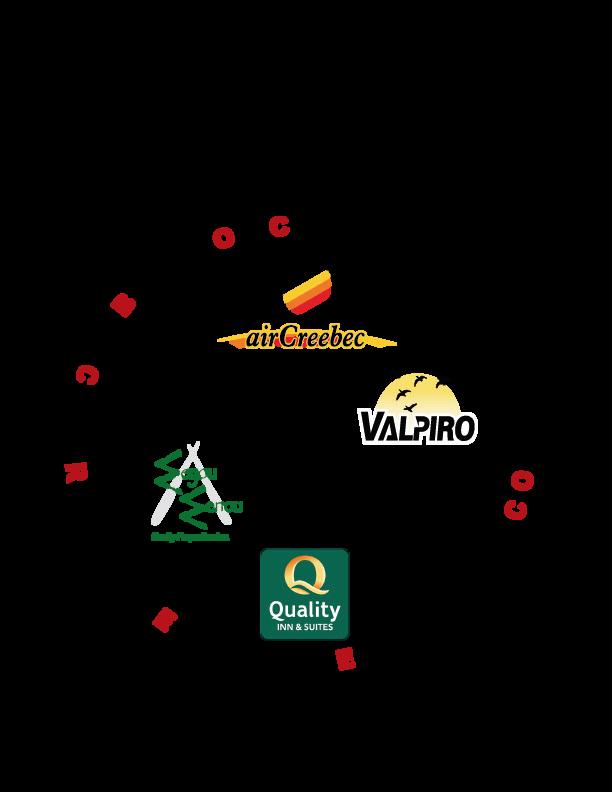







by Patrick Quinn, Local Journalism Initiative Reporter
Could “America’s Next Top Hitmaker” be a Cree gangsta rapper? On June 25, Hank “Jigap” Visitor learned that he’d been selected for the popular contest run by Rolling Stone magazine. The winner will receive $10,000, a concert showcase in Austin, Texas, and a mentoring session with hip-hop legend Busta Rhymes.
Jigap’s entry is an impressive one-minute cover of Outkast’s 2000 hit “Bombs Over Baghdad”, matching André 3000’s frantic flow with rapid-fire rapping in the Cree language. He said the whole process of writing, recording and taking the cellphone video took less than 10 minutes.
“I got a text in the middle of work saying I’ve been selected for America’s Next Top Hitmaker,” Visitor recalled. “I couldn’t believe it. I’ve heard some people say they knew me for years and I didn’t speak the Cree language very well. I worked on it.”
Having lived in each community except Whapmagoostui, Visitor is working on a concept album blending inland and coastal dialects that will feature a song for each community in Eeyou Istchee. One of his newest songs namechecks almost every street in Waswanipi, where he’s currently based, even a drinking party at the old baseball field.
Visitor’s also working on his “first album” that mixes English and Cree, with one crunk-style chorus showcas-

ing local slang like Chisasibi’s “ouwah” and Wemindji’s “neh.” He worked with Merkules on “Straight James Bay Coasting” about two weeks before Snoop Dogg signed the BC rapper to Death Row Records.
“Merkules said don’t you want to do solid English because most people don’t speak Cree?” Visitor shared. “I said most people don’t speak Spanish, but they’ll still listen because they love the beat and the way it sounds. I will not be told not to speak my language.”
The song was produced by Cree musician Paul Napash, who has amassed over 500 beats since the early 2000s when the two first met as teenagers in Chisasibi. They recently reconnected with plans to collaborate on upcoming productions featuring artists on Visitor’s independent label, Screaming Eagle Sound.
“If an artist makes me want to make a certain kind of beat, I can make something similar,” said Napash. “I have over 5,000 sounds on my computer, and
everything is categorized so I can easily find the sound I’m looking for.”
Given the name Hank Williams by his late father, Cree country music troubadour Robert F. Visitor, Jigap remembers being a kid “hepped up on sugar” walking around almost every community with a plastic suitcase full of his dad’s tapes. Selling for $15, he’d often outsell other family members, earning hundreds in tips when people gave $20 bills.
When they once went to Val-d’Or without money, his father said, “Don’t worry, I brought my guitar.” After starting to play in the Chateau Laurier, the bar was soon filled with Crees who quickly filled his guitar case. He then went to the Moose Hotel and did the same thing.
“Then he said, ‘Son, go down to the Continental and get us a room for three nights’,” said Visitor. “He said, ‘I have money wherever I go. As long as our people are here, they love to hear the Cree language’.”

Writing verses daily since hearing Eminem at age 13, Visitor was seeking a rap name when Nemaska teacher Annie Whiskeychan told him “jigap” was the Cree word for marijuana. As he smokes when he writes and feels like “the dopest rapper” when he sees people react to his music, the name stuck.
Freestyling with friends at school and parties, Visitor’s first brush with fame came in 2004 when Wemindji youth arts animator Sarah DeCarlo asked who could do a Cree language rap. Paid to play the cover of 2Pac’s “Changes” at a talent show, Visitor was “mortified” when he heard the recording repeatedly playing on local radio at the grocery store.
“I had the biggest anxiety attack,” said Visitor. “I walked home so fast and every single car at the mini mall was playing Changes. It was an unfinished demo I had intended to put more Cree language on. I was very upset about it – then I started getting phone calls to come to other communities.”
With everyone asking about the song, Visitor retreated from this “surreal” popularity, wanting to release his own originals when he was ready. Now when he hears Changes played at parties, he can appreciate being “the first guy to ever do Cree language hip-hop on JBCCS radio.”
“That was the first time I had a taste of Cree rap,” said former schoolmate Steve Einish. “I would see Hank around my buddy’s place creating stuff. Last time I seen Hank I was like where’s that song, man?”
After getting back into music creation during the pandemic, Einish has taken Cree hip-hop to new heights as Kong, a nickname Visitor said was bestowed by “the hood.” As he prepared for a prestigious opening slot for Wu-Tang’s Method Man, Einish suggested any Cree success is a team effort for the Nation
“It’s good for our youth to see people from our area can get that type of exposure,” said Einish. “It’s powerful to see people who came from not so good circumstances rise above it – I want to tell him to keep on pushing.”
While Visitor raps about his past selling crack on the toughest streets of Montreal and Ottawa, he knows this life only leads to jail, overdose or death. He left that behind when he had his daughter, embracing the Cree traditional life. Spending months in the bush with his Aunt Louise Mayappo was a full immersion in the Cree language.
Now working as a translator for CBC, Visitor has recently been dubbing Aladdin songs and Rick and Morty cartoons into Cree. With multiple projects nearing completion, perhaps even a heavy metal album, Jigap is in it for the passion and the fun.
“I’m seeing youth relearn the language because they find the cartoons funny and the music catchy and want to know what I’m saying,” said Visitor. “Ever since I got on Top Hitmaker, I see rappers start trying to do Cree language. I’m pretty happy about it – I want to revive the language.”

















ere’s another edition of the Nation’s puzzle page. Try your hand at Sudoku or Str8ts or our Crossword, or better yet, solve all three and send us a photo!* As always, the answers from last issue are here for you to check your work. Happy hunting.

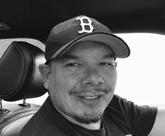

by Sonny Orr
he mysterious universe has cloaked us with deep memories and calls out to those who wish to hear what they want to hear. Yes, the inner voice which doesn’t seem to belong to anyone except yourself, urging you to do idiotic things that no one in their right mind would ever think of doing. Except for you in your deep thought, plotting things based on the inner dark thoughts.
I’m talking about crazy people who will do anything to get attention and blame it on the little voice in their head. Yes, take the shot, your funeral will be glorious… At this point, I’m just guessing what goes on in an unstable mind, but something must go on in those people who decide. Yup, after I eat my breakfast of fortified granola, I’ll go take down a former US president on live TV.
Does that sound like someone with a few loose screws to hold their brain firmly together? Or does it sound like someone who plotted this event like an assassination attempt on Donald Trump at a campaign rally?
I don’t think that it was a spur-of-themoment idea that turned into a near kill by a millimetre off, due to an erratic head movement flicking that orange hair out of the way. Whatever it was, it made the Trump angry enough to sputter out the f-word – “Fight!” – to a crowd that didn’t seem too fazed and actually clapped. Wow, I thought, how American.
So, I checked out the facts just to be sure and yup, the Trump didn’t stop. President Joe urged the public to tone it down a notch, so that no one gets too excited and triggers a military coup. This just might happen if things keep going the way they are now, with democracy spinning out of control and too much (uncontrolled) freedom being just as dicey to deal with as not enough freedom.
So, what next? More fanatical politicking or a more laid-back, practically semi-retired, approach. There doesn’t seem to be a middle ground when it comes to wanting the top job in town, in this case, as President of the United States.
How do we handle our own election campaigns? In a small discussion over politics, which just happens to be in the coffee room, a memory of a whole election process from nominations to elections and appointment to duty, rested on one person. That person would take over the meeting and carry out every detail from counting votes, nominations, double checking the votes for clarity and appointing the chief and council in under 20 minutes – or so it was told to me.
Amazing, I thought! But the reality was at that time, there weren’t thousands of voting-age adults to handle and everyone at the meeting, well, they were the ones who ran the town anyways.
Eventually, things got a bit more organized when it came to voting for your
favourite family member and even a campaign promise or two to spice things up in favour of your best family candidate. Then secret ballots became popular, so no one could find out if their mother voted against them in favour of the more handsome candidate.
In recent times, most women voters held their breath until election day was over only to gush that their favourite and best-looking prime minister ever, had won. Due to, of course, the overwhelming response from female voters. I’m sure that many other voters based their choice on that premise, so I rest my case. To strengthen this assessment, I hardly ever get any votes when I run, probably based on the same prejudice which is not in my favour.
So, I’ve decided not to run for anything, except for the washroom in the middle of the night, and not to make promises that I can’t keep, like getting that new house or plum job for a nephew, or to hold my meeting in the community of my choice, like Montreal. Now, that’s a great community! And finally, free paycheques on payday for those who already have jobs.
Yeah, I can see it now, my new council position. Just as long as no one takes a pot shot at me, because I don’t have that hair to flick out of the way just in time to save my life.


by Xavier Kataquapit
Inever quite realized how hard life was when I was growing up in Attawapiskat in the 1980s, even though our Elders were seeing the community start to modernize and become more comfortable than the life they had known.
We had a routine on summer mornings when there was no school. My dad Marius would wake with the dawn just as he always did when he grew up on the land. My mom Susan would do the same and in the blue light of the early morning we’d hear them in the kitchen brewing a batch of strong orange pekoe tea.
We had a three-bedroom home for nine children and our two parents. Mom and dad had their room, my two sisters had theirs and the rest of us seven boys packed into one room with bunks and a twin bed all squeezed in together with barely enough room to walk.
We never wanted to rise as early as our parents, so we lay in bed as long as possible. As soon as we heard the tinkling of them stirring their porcelain teacups after adding canned milk and sugar, we knew that a large pot of oatmeal was on the way. Dad would eat toast or leftovers before heading out to work.
It was at that point that they both started calling into our bedrooms for us to rise out of bed, “Oo-nish-kah Eh-koh! (Wake up! Now!).
Morning was busy. There was no running water so going to the bathroom meant using a honey bucket. The number of people in the house meant that the five-gallon bucket quickly filled up. When it was full, mom would task one of the older boys or girls to take it to the outhouse behind our home to empty. Remember, this was the late 1980s and we still had no indoor plumbing or running water.
Mom heated water for us so we could wash our hands and faces in a large basin. We all rushed to the bathroom as we knew that being the last would mean having to wash up in grey, soapy liquid. The last person was also tasked with having to empty the grey water into a waste

After an hour or two in the summer sun she would take the dry clothes down from the line. She did this every day all year, even when it was -30
bucket and to dump it in a drainage ditch next to our home.
We all sat down to eat thick porridge and drink a cup of tea. Our aim was to fill our cups and bowls with milk and sugar, but mom always rationed us just enough as no one was allowed to eat in excess. We weren’t starving for food, but our parents were not wealthy and had to budget wisely.
I am the third youngest in my family, so my two younger brothers and I were often exempt from the chores mom assigned to the older children. Someone was tasked with the honey bucket, someone for the grey bathroom water and another to help her with a huge metal bucket of water to heat on the stove for the daily laundry. Someone else heated more water to wash the breakfast dishes.
After breakfast, we would leave the house to go about our day. Mom stayed behind to start the monumental task of doing laundry for all 11 of us. When the water was hot enough, she put the first load in her wringer washing machine. The hot water was poured into the wringer washer and then manually drained at the end of the cycle into buckets to be carried to the ditch. Mom took the wet clothing from the water then rinsed each item through the wringer.
If one of us happened to still be around once the first load was done, she would ask us to help her carry the wet clothes outside to hang on the line. After an hour
or two in the summer sun she would take the dry clothes down from the line. She did this every day all year, even when it was -30.
This was a chore that she would repeat multiple times daily as the laundry hamper never emptied. As she washed, more dirty clothes kept appearing. Dad often wasn’t around in the mornings as he was already working outside with my older brothers. They were busy restocking our supply of firewood for the coming winter, cleaning the yard, maintaining hunting equipment and the 24-foot freighter canoe, or servicing a snow machine so it would last the winter.
They also worked on an outboard motor, chainsaw and the run-down truck used to move things around the community. There was no option to hire mechanics, visit a service station or run to a hardware store. Every hunter and trapper like dad had to figure out how to maintain everything with what was available.
In 1990, Attawapiskat finally was equipped with running water and a drainage system thanks to the Liberal and then New Democratic Party governments of the time. It meant a world of difference for housewives like mom as her daily workload was lightened.
There was still plenty of work to be done, but at the very least we were done complaining about who had to empty the honey bucket.
